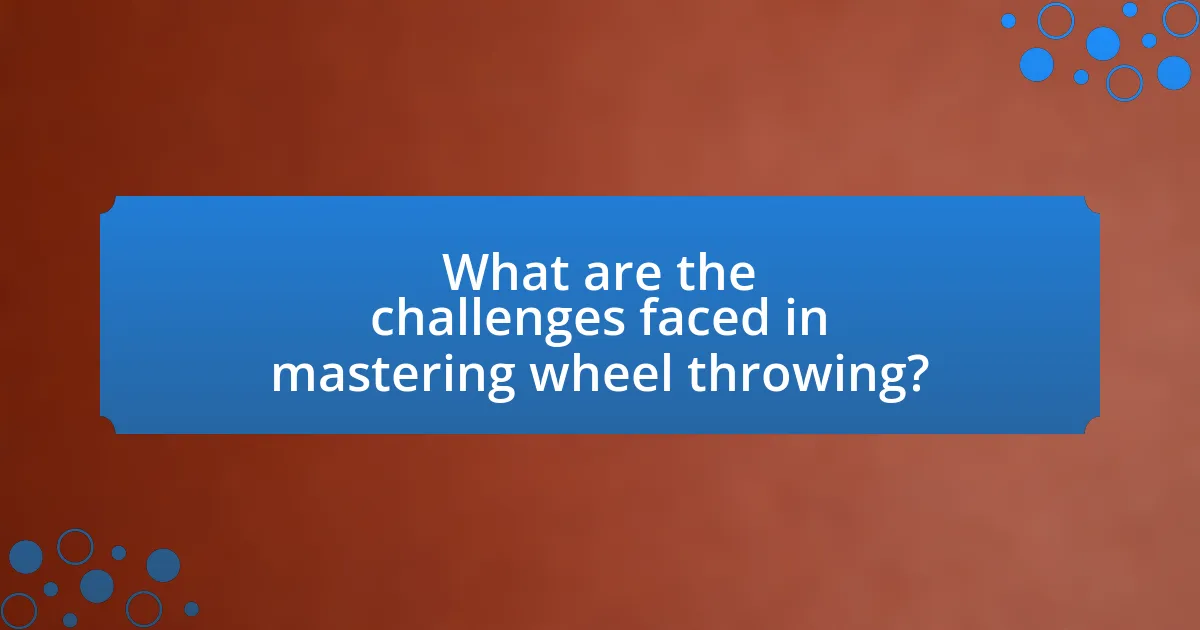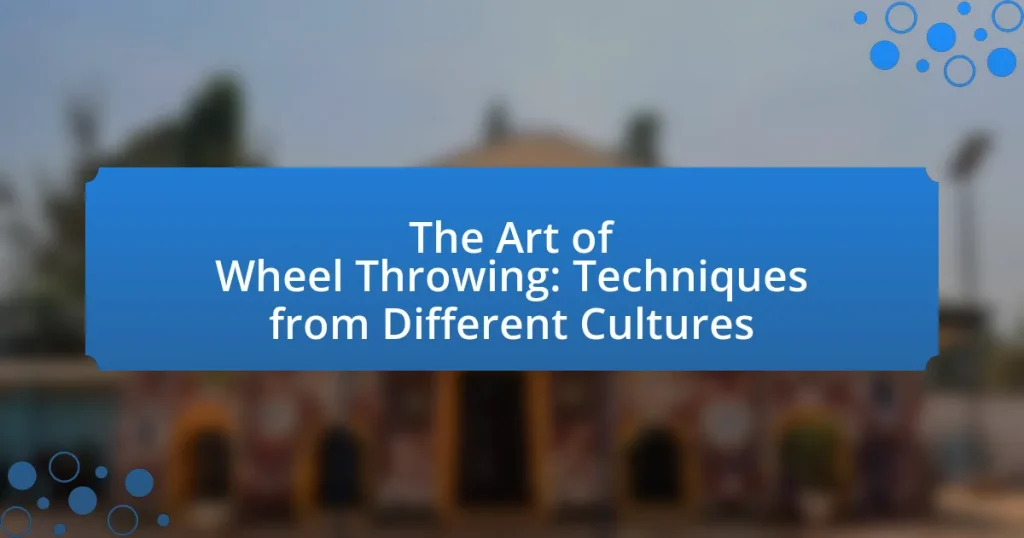The art of wheel throwing is a pottery technique that involves shaping clay on a rotating wheel to create various ceramic objects, with historical roots tracing back to ancient Mesopotamia around 3500 BCE. This article explores the origins of wheel throwing across different cultures, including Mesopotamia, China, and the Indus Valley, highlighting significant milestones in its development. It examines how cultural influences shape techniques and aesthetics, the fundamental methods involved, and the essential tools required for the craft. Additionally, the article addresses modern innovations, community practices, and the challenges faced by potters, providing a comprehensive overview of the diverse practices and techniques in wheel throwing globally.

What is the Art of Wheel Throwing?
The art of wheel throwing is a pottery technique that involves shaping clay on a rotating wheel to create functional and decorative ceramic objects. This method allows for precise control over the form and symmetry of the piece, enabling artisans to produce items such as bowls, vases, and plates. Historically, wheel throwing has been practiced in various cultures, with evidence dating back to ancient Mesopotamia around 3500 BCE, showcasing its significance in the development of ceramic arts globally.
How did wheel throwing originate in different cultures?
Wheel throwing originated independently in various cultures, primarily in Mesopotamia, China, and the Indus Valley. In Mesopotamia, evidence from around 3500 BCE shows that the potter’s wheel was used for shaping clay, enhancing efficiency and precision in pottery production. Similarly, in China, the earliest known use of the potter’s wheel dates back to approximately 3000 BCE, where it played a crucial role in the development of ceramics. The Indus Valley civilization also utilized wheel throwing around 2500 BCE, as indicated by archaeological findings of pottery with uniform shapes and designs. These instances demonstrate that wheel throwing emerged as a significant technological advancement in pottery across different regions, driven by the need for improved craftsmanship and production methods.
What are the historical milestones in the development of wheel throwing?
The historical milestones in the development of wheel throwing include its inception in Mesopotamia around 3500 BCE, where the potter’s wheel was first used, significantly enhancing pottery production efficiency. By 3000 BCE, the technology spread to Egypt, allowing for more intricate designs and uniform shapes. The introduction of the fast wheel in the 1st millennium BCE in the Mediterranean region further revolutionized the craft, enabling potters to create larger and more complex forms. In Asia, particularly in China, wheel throwing became prominent during the Shang Dynasty (1600-1046 BCE), leading to the development of high-fired ceramics. These milestones illustrate the evolution of wheel throwing as a pivotal technique in pottery across various cultures.
How have cultural influences shaped the techniques of wheel throwing?
Cultural influences have significantly shaped the techniques of wheel throwing by introducing diverse styles, materials, and practices that reflect regional traditions and artistic values. For instance, Japanese pottery techniques, such as those seen in the Mingei movement, emphasize simplicity and natural forms, leading to a distinct approach in wheel throwing that prioritizes craftsmanship and aesthetic harmony. In contrast, ancient Greek pottery techniques showcased intricate designs and functional forms, influencing the way potters utilized the wheel to create both decorative and utilitarian pieces. Additionally, the use of local clay types and glazes in different cultures has led to variations in the final products, demonstrating how cultural context directly impacts the methods and outcomes of wheel throwing.
What are the fundamental techniques involved in wheel throwing?
The fundamental techniques involved in wheel throwing include centering, opening, pulling, shaping, and trimming. Centering is the initial step where the clay is placed on the wheel and spun to achieve a balanced mass. Opening involves creating a hollow space in the centered clay, which is essential for forming the vessel. Pulling refers to the technique of raising the walls of the pot by applying pressure with the hands while the wheel spins. Shaping is the process of refining the form of the piece, adjusting its height and width. Finally, trimming is done after the piece has dried to refine its shape and remove excess clay. These techniques are foundational in pottery and have been practiced across various cultures, demonstrating their universal importance in the art of wheel throwing.
What tools and materials are essential for wheel throwing?
Essential tools and materials for wheel throwing include a potter’s wheel, clay, water, and various hand tools. The potter’s wheel is crucial for shaping the clay into desired forms through rotation. Clay, specifically stoneware or earthenware, provides the malleability needed for creating pottery. Water is essential for maintaining the right consistency of the clay and for smoothing surfaces during the throwing process. Hand tools such as rib tools, trimming tools, and sponges assist in refining shapes and details. These components are foundational in the practice of wheel throwing, as they directly influence the quality and precision of the finished pottery.
How does the process of centering clay work in wheel throwing?
Centering clay in wheel throwing involves applying even pressure to the clay mass while it spins on the wheel. This process begins with the potter placing a lump of clay in the center of the wheel head and wetting it to reduce friction. As the wheel spins, the potter uses their hands to compress and shape the clay, gradually moving it upward and inward to achieve a symmetrical form. The goal is to eliminate any wobble and ensure that the clay is evenly distributed around the axis of rotation, which is crucial for creating uniform pottery. Proper centering is essential because it directly affects the stability and quality of the final piece.
What are the variations of wheel throwing techniques across cultures?
Variations of wheel throwing techniques across cultures include distinct methods and styles that reflect regional traditions and materials. For instance, Japanese pottery often employs a technique called “kōgei,” which emphasizes precision and aesthetic beauty, while Korean pottery features a technique known as “onggi,” focusing on functional forms and traditional glazes. In contrast, Western ceramics, particularly in the studio pottery movement, prioritize individual expression and experimentation with forms and glazes. Historical evidence shows that these cultural practices have evolved over centuries, influenced by local resources and artistic philosophies, such as the use of stoneware in Germany and earthenware in Mexico, highlighting the diversity in wheel throwing techniques globally.
How does Japanese wheel throwing differ from Western methods?
Japanese wheel throwing primarily differs from Western methods in its emphasis on a more tactile and intuitive approach, often utilizing a slower wheel speed and a focus on the potter’s physical connection with the clay. In Japan, potters typically use a kick wheel, which allows for greater control and a more organic feel during the throwing process, contrasting with the electric wheels commonly used in Western practices that often prioritize speed and efficiency. This tactile method fosters a deeper relationship between the artisan and the material, resulting in unique forms and textures that reflect traditional Japanese aesthetics.
What unique practices are found in African wheel throwing traditions?
African wheel throwing traditions incorporate unique practices such as the use of locally sourced clay, specific regional techniques, and cultural motifs in pottery design. For instance, potters in Nigeria often utilize a technique called “coiling” alongside wheel throwing to create intricate forms, while in South Africa, the incorporation of traditional patterns and symbols reflects cultural heritage. Additionally, the communal aspect of pottery making is significant, where knowledge and skills are passed down through generations, emphasizing the importance of community in the craft. These practices highlight the blend of functionality and artistry in African pottery, showcasing a rich cultural narrative.

How do cultural contexts influence wheel throwing techniques?
Cultural contexts significantly influence wheel throwing techniques by shaping the materials, styles, and purposes of pottery. For instance, in Japanese culture, the use of stoneware and specific throwing methods reflects a deep appreciation for aesthetics and functionality, as seen in the tradition of Raku pottery, which emphasizes spontaneity and natural forms. In contrast, Native American cultures often incorporate local clay types and traditional designs that convey cultural narratives, resulting in distinct throwing techniques that prioritize storytelling and heritage. These variations demonstrate how cultural values and environmental factors directly impact the approach to wheel throwing, leading to diverse practices and outcomes in pottery across different societies.
What role does tradition play in the practice of wheel throwing?
Tradition plays a crucial role in the practice of wheel throwing by preserving techniques, styles, and cultural significance across generations. Various cultures, such as Japanese and Native American, have established specific methods and rituals associated with wheel throwing that reflect their historical contexts and artistic values. For instance, in Japan, the practice of “raku” pottery emphasizes a communal approach and spiritual connection, which has been passed down for centuries, influencing contemporary practices. This adherence to tradition not only maintains the integrity of the craft but also fosters a sense of identity and continuity within communities engaged in wheel throwing.
How do cultural beliefs affect the aesthetics of wheel-thrown pottery?
Cultural beliefs significantly influence the aesthetics of wheel-thrown pottery by dictating design choices, color palettes, and symbolic motifs. For instance, in Japanese pottery, the concept of wabi-sabi emphasizes simplicity and imperfection, leading to aesthetic choices that celebrate natural forms and earthy tones. In contrast, Native American pottery often incorporates intricate patterns and vibrant colors that reflect spiritual beliefs and cultural narratives, showcasing the importance of storytelling in their designs. These cultural frameworks shape not only the visual aspects of the pottery but also the materials used and the techniques employed, reinforcing the connection between cultural identity and artistic expression.
What are the community practices surrounding wheel throwing in different cultures?
Community practices surrounding wheel throwing vary significantly across cultures, reflecting local traditions and social structures. In Japan, for instance, the practice is often embedded in a communal setting where potters gather to share techniques and participate in festivals celebrating pottery, such as the annual Tokoname Pottery Festival. In contrast, in Mexico, wheel throwing is frequently integrated into family businesses, where skills are passed down through generations, emphasizing the importance of familial ties in the craft. Additionally, in the United States, community studios often host workshops and collaborative events, fostering a sense of community among potters and encouraging the exchange of ideas and techniques. These practices highlight the cultural significance of wheel throwing, as they not only focus on the craft itself but also on the relationships and traditions that sustain it.
How do modern innovations impact traditional wheel throwing?
Modern innovations significantly enhance traditional wheel throwing by introducing advanced materials and technologies that improve efficiency and precision. For instance, electric pottery wheels allow for consistent speed control, enabling potters to focus on technique rather than manually adjusting wheel speed. Additionally, the use of high-quality, lightweight clay bodies and glazes, developed through modern chemistry, results in stronger and more versatile finished products. These innovations not only streamline the throwing process but also expand the creative possibilities for artists, allowing for more intricate designs and forms that were previously difficult to achieve.
What technologies are being integrated into wheel throwing today?
Modern wheel throwing integrates technologies such as electric wheels, digital speed controls, and 3D printing. Electric wheels enhance efficiency and reduce physical strain, allowing potters to focus on technique rather than manual effort. Digital speed controls enable precise adjustments to wheel rotation, improving consistency in shaping clay. Additionally, 3D printing technology is being explored for creating molds and tools that assist in the wheel throwing process, allowing for innovative designs and faster production times. These advancements reflect a blend of traditional craftsmanship with contemporary technological innovations, enhancing the overall practice of wheel throwing.
How are contemporary artists blending traditional techniques with modern styles?
Contemporary artists are blending traditional techniques with modern styles by incorporating age-old methods, such as wheel throwing, into innovative designs and materials. For instance, artists often utilize traditional pottery techniques from various cultures, like Japanese raku or Native American coil building, while experimenting with contemporary glazes and forms that reflect modern aesthetics. This fusion not only preserves cultural heritage but also allows for the exploration of new artistic expressions, as seen in the works of artists like Grayson Perry, who combines historical pottery forms with contemporary themes and narratives.

What are the challenges faced in mastering wheel throwing?
Mastering wheel throwing presents several challenges, including achieving consistent centering, controlling the speed of the wheel, and managing clay consistency. Consistent centering is crucial as it affects the symmetry and balance of the piece; even slight deviations can lead to uneven forms. Controlling the speed of the wheel is essential for maintaining the desired shape and thickness, as too fast or too slow can result in distortion. Additionally, managing clay consistency is vital; variations in moisture content can lead to cracking or difficulty in shaping. These challenges require practice and skill development, as evidenced by the fact that many potters spend years refining their techniques to overcome these obstacles.
What common mistakes do beginners make in wheel throwing?
Beginners in wheel throwing commonly make mistakes such as improper centering of the clay, inadequate pressure application, and neglecting to maintain consistent speed. Improper centering leads to uneven shapes, as the clay must be perfectly centered on the wheel to achieve symmetry. Inadequate pressure application can result in weak walls that collapse during shaping, while neglecting consistent speed can cause the clay to become misshapen or uneven. These mistakes are frequently observed in novice potters and can significantly hinder their progress in mastering the technique.
How can one overcome difficulties in centering and shaping clay?
To overcome difficulties in centering and shaping clay, one should focus on proper technique and consistent practice. Ensuring that the clay is adequately wedged before throwing helps eliminate air bubbles and inconsistencies, which can hinder centering. Additionally, using a steady hand and applying even pressure while pulling the clay upwards can significantly improve shaping. Research indicates that practicing mindfulness and body positioning can enhance control and precision during the wheel-throwing process, as demonstrated in various pottery workshops worldwide.
What tips can enhance the wheel throwing experience?
To enhance the wheel throwing experience, focus on maintaining proper posture and centering the clay effectively. Proper posture allows for better control and balance, which is crucial for successful throwing. Centering the clay is essential as it ensures uniformity and stability during the shaping process. Additionally, using consistent pressure and speed while throwing helps achieve desired forms and reduces the risk of warping. Practicing regularly and experimenting with different clay types can also improve skills and adaptability. These techniques are supported by pottery experts who emphasize the importance of body mechanics and material familiarity in achieving proficiency in wheel throwing.
How can practice routines improve wheel throwing skills?
Practice routines can significantly enhance wheel throwing skills by providing structured repetition and focused improvement on specific techniques. Consistent practice allows potters to develop muscle memory, which is crucial for achieving precision and control during the throwing process. Research indicates that deliberate practice, characterized by focused and goal-oriented sessions, leads to measurable improvements in skill acquisition and performance. For instance, a study published in the Journal of Experimental Psychology found that individuals who engaged in structured practice routines showed a 20% increase in their performance metrics compared to those who practiced without a clear focus. This evidence supports the notion that well-designed practice routines are essential for mastering the complexities of wheel throwing.
What resources are available for learning wheel throwing techniques?
Resources available for learning wheel throwing techniques include instructional books, online courses, and pottery workshops. Notable books such as “The Complete Guide to Wheel Throwing” by John Britt provide comprehensive insights into techniques and practices. Online platforms like Skillshare and Udemy offer video tutorials that cover various aspects of wheel throwing, allowing learners to practice at their own pace. Additionally, local pottery studios often host workshops where experienced instructors guide participants through hands-on learning experiences, facilitating skill development in a supportive environment.


